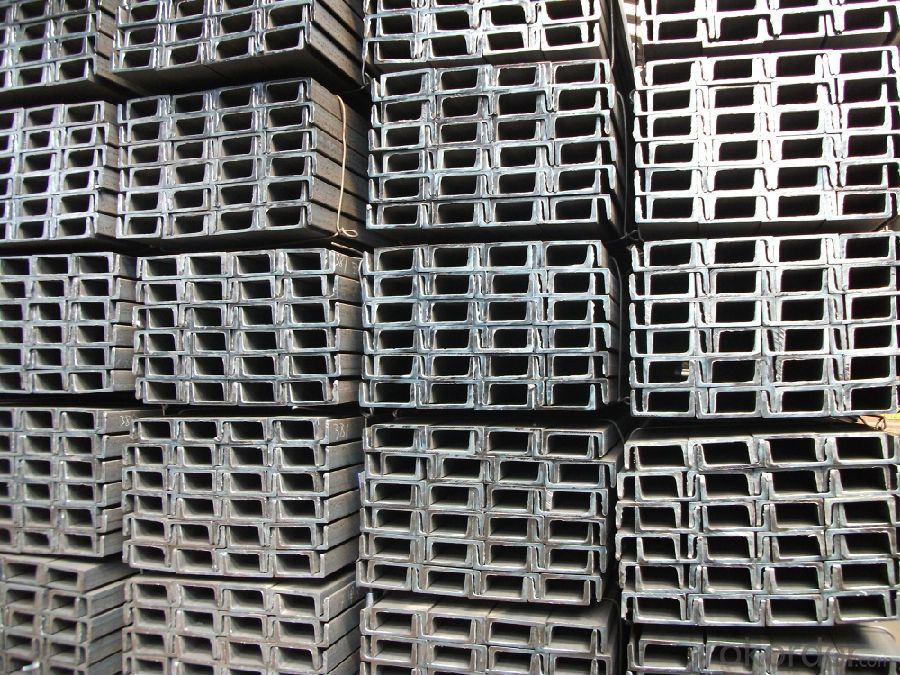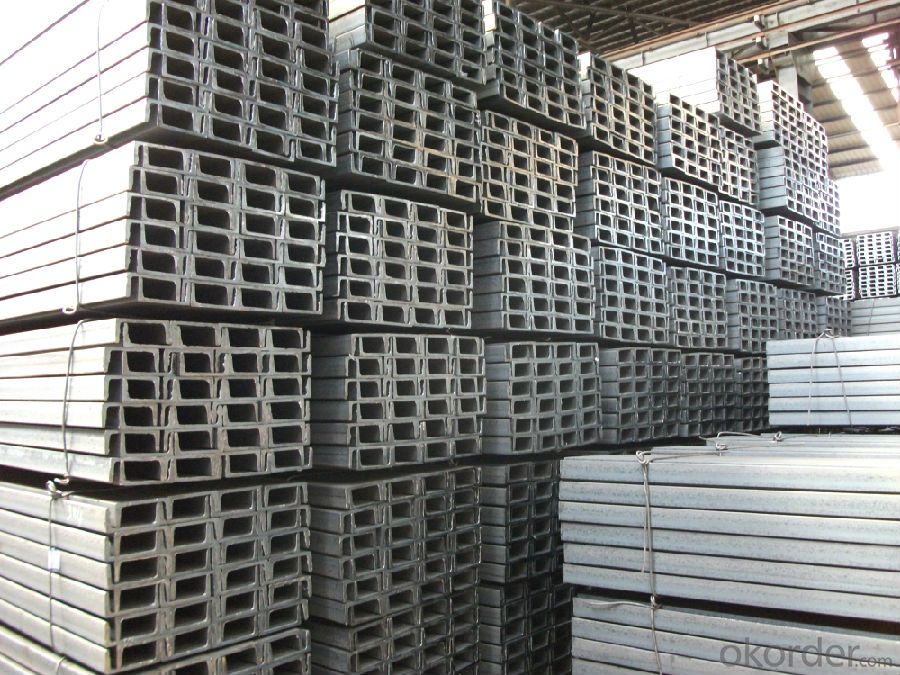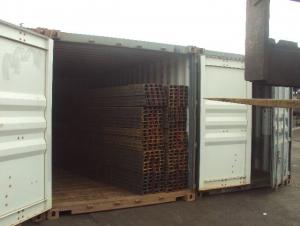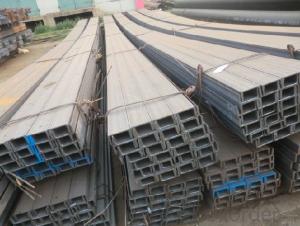U-channel JIS Standard with Different Sizes
- Loading Port:
- Tianjin
- Payment Terms:
- TT or LC
- Min Order Qty:
- 25 m.t.
- Supply Capability:
- 1000 m.t./month
OKorder Service Pledge
OKorder Financial Service
You Might Also Like
Product Description:
OKorder is offering U-channel at great prices with worldwide shipping. Our supplier is a world-class manufacturer of steel, with our products utilized the world over. OKorder annually supplies products to European, North American and Asian markets. We provide quotations within 24 hours of receiving an inquiry and guarantee competitive prices.
Product Applications:
1.The JIS channel can be devided into two kinds, namely common channel steel and light channel steel. The sizes of hot rolled common channel steel range from 5# to 40#. Meanwhile, the channel steel can be divided into cold forming sectional equal channel steel, cold forming sectional unequal channel steel, cold forming inner edge channel steel and outer edge channel steel.
2.The JIS channel is usually used for arch-itechtural structure, and they could be welded in order to support or hang a vari-ety of facilities. They are also usually used in combination with I beam. The channel steel with sizes under 14# is usually applied to construction engineering, as purline, while the channel steel with sizes above 16# is more likely to be used in building vehicle chassis structure and mechanical structure. Furthermore, the channel steel in sizes above 30# are target at building bridge structure, as tension bar.
Product Advantages:
OKorder's U-channel are durable, strong, and resist corrosion.
Main Product Features:
· Premium quality
· Prompt delivery & seaworthy packing (30 days after receiving deposit)
· Corrosion resistance
· Can be recycled and reused
· Mill test certification
· Professional Service
· Competitive pricing
Product Specifications:
1. We are definitely speciallizing in manufacturing and supplying channel steel as per japanese standard, which is characterised with high mechanical strength and competitive prices.
2. The sections in details are as followings in the table-1
JIS CHANNEL | Standard h | Sectional b | Dimension s | t | Mass: Kg/m |
(mm) | (mm) | (mm) | (mm) | ||
50x25 | 50 | 25 | 3.0 | 6.00 | 2.37 |
75X40 | 75 | 40 | 3.8 | 7.00 | 5.30 |
75X40 | 75 | 40 | 4.0 | 7.00 | 5.60 |
75X40 | 75 | 40 | 4.5 | 7.00 | 5.85 |
75X40 | 75 | 40 | 5.0 | 7.00 | 6.92 |
100X50 | 100 | 50 | 3.8 | 6.00 | 7.30 |
100X50 | 100 | 50 | 4.2 | 6.00 | 8.03 |
100X50 | 100 | 50 | 4.5 | 7.50 | 8.97 |
100X50 | 100 | 50 | 5.0 | 7.50 | 9.36 |
125X65 | 125 | 65 | 5.2 | 6.80 | 11.66 |
125X65 | 125 | 65 | 5.3 | 6.80 | 12.17 |
125X65 | 125 | 65 | 5.5 | 8.00 | 12.91 |
125X65 | 125 | 65 | 6.0 | 8.00 | 13.40 |
150x75 | 150 | 75 | 5.5 | 7.30 | 14.66 |
150x75 | 150 | 75 | 5.7 | 10.00 | 16.71 |
150x75 | 150 | 75 | 6.0 | 10.00 | 17.90 |
150x75 | 150 | 75 | 6.5 | 10.00 | 18.60 |
150x75 | 150 | 75 | 6.5 | 10.00 | 24.00 |
200X80 | 200 | 80 | 7.5 | 11.00 | 24.60 |
Packaging & Delivery of U-channel:
Packaging Detail: products are packed in coil, each coil weight around 2 MT, and then shipped by container or bulk vessel
Delivery Detail: within 45 days after received deposit or LC.
Label: to be specified by customer, generally, each bundle has 1-2 labels
Trade terms: FOB, CFR, CIF
FAQ:
Q1: How soon can we receive the product after purchase?
A1: Within three days of placing an order, we will begin production. The specific shipping date is dependent upon international and government factors, but is typically 7 to 10 workdays.
Q2: What makes stainless steel stainless?
A2: Stainless steel must contain at least 10.5 % chromium. It is this element that reacts with the oxygen in the air to form a complex chrome-oxide surface layer that is invisible but strong enough to prevent further oxygen from "staining" (rusting) the surface. Higher levels of chromium and the addition of other alloying elements such as nickel and molybdenum enhance this surface layer and improve the corrosion resistance of the stainless material.
Q3: Can stainless steel rust?
A3: Stainless does not "rust" as you think of regular steel rusting with a red oxide on the surface that flakes off. If you see red rust it is probably due to some iron particles that have contaminated the surface of the stainless steel and it is these iron particles that are rusting. Look at the source of the rusting and see if you can remove it from the surface.
Images:


- Q:How do steel channels contribute to the overall stability of a telecommunications tower?
- Steel channels contribute to the overall stability of a telecommunications tower by providing structural support and rigidity. They are used as vertical and horizontal members in the tower's framework, helping to distribute the load evenly and resist any external forces such as wind or seismic activity. The channels also help to maintain the tower's shape and prevent deformation, ensuring its stability and longevity.
- Q:What are the different methods of fastening steel channels?
- Depending on the specific application and requirements, there are various methods available for fastening steel channels. Some commonly used methods include: 1. The traditional and widely used method involves using bolts and nuts. In this method, bolts are inserted through pre-drilled holes in the channel and secured with nuts on the opposite side, ensuring a strong and secure connection. 2. Welding is a commonly used method for fastening steel channels, particularly in permanent and structurally critical applications. This method involves heating and fusing the steel channel to another steel component or structure, resulting in a strong and seamless connection. 3. Rivets can also be used to fasten steel channels. This method involves inserting a rivet through pre-drilled holes and securing it by deforming the end of the rivet. It is often used in applications requiring high shear strength. 4. Adhesive bonding offers the advantage of a clean and aesthetically pleasing appearance. High-strength adhesives or epoxy resins are used to bond steel channels together, eliminating the need for visible fasteners. 5. Clamps provide a tight grip around the steel channel, securing it to another component or structure. This method is commonly used for temporary or adjustable connections. 6. Self-tapping screws are another option for fastening steel channels to other steel components. These screws have a pre-formed thread that allows them to cut into the steel as they are screwed in, providing a secure connection without the need for pre-drilled holes. 7. Brackets and clips are often used to fasten steel channels to walls, ceilings, or other structures. These accessories offer a secure and adjustable connection, facilitating easy installation and adjustment if required. When selecting the most suitable method for fastening steel channels, it is crucial to consider the specific requirements of the application, including load capacity, aesthetics, and accessibility.
- Q:Can steel channels be used for conveyors?
- Certainly, conveyors can utilize steel channels. In conveyor systems, steel channels are usually employed to furnish structural reinforcement and steadfastness. They frequently serve as the backbone for the conveyor system, furnishing a robust foundation for other constituents like rollers, belts, and motors. Steel channels present exceptional strength, durability, and resilience to deterioration, rendering them appropriate for managing substantial loads and extended periods of operation. Furthermore, steel channels can be conveniently personalized and manufactured to accommodate precise conveyor needs, offering versatility in both design and installation.
- Q:How do steel channels contribute to earthquake-resistant structures?
- There are several ways in which steel channels contribute to earthquake-resistant structures. To begin with, steel channels play a crucial role in providing strength and stability to the structure. They are frequently utilized as structural elements, such as beams and columns, that bear the weight of the building. Steel channels are renowned for their exceptional strength-to-weight ratio, enabling them to withstand heavy loads while remaining relatively lightweight. This strength assists the structure in enduring the powerful forces generated during an earthquake. Furthermore, steel channels can serve as reinforcements in concrete structures. By embedding steel channels within the concrete, the overall structural integrity is enhanced. During an earthquake, the steel channels aid in distributing the forces and stresses throughout the structure, preventing localized damage. This reinforcement technique is commonly utilized in the construction of walls, floors, and foundations. Moreover, steel channels can also function as bracing elements in earthquake-resistant structures. Bracing systems augment the rigidity and ductility of the building, enabling it to absorb and dissipate seismic energy. Steel channels can be strategically positioned within the framework of a building to provide additional resistance against lateral forces, such as those caused by earthquakes. This helps minimize the overall deformation of the building and prevents collapse. Additionally, steel channels offer flexibility in terms of design and construction. They can be easily fabricated and installed, facilitating the efficient construction of earthquake-resistant structures. Their versatility allows engineers to devise innovative and tailored solutions to meet specific seismic design requirements. In summary, steel channels contribute to earthquake-resistant structures by furnishing strength, stability, reinforcement, and bracing. Their exceptional strength-to-weight ratio, capacity to distribute forces, and design adaptability make them an indispensable component in ensuring the safety and resilience of buildings during seismic events.
- Q:Can steel channels be used for framing in construction?
- Indeed, framing in construction can utilize steel channels. These channels, referred to as C-channels or U-channels, are frequently employed in construction as structural elements for framing purposes. They possess exceptional strength and stability, rendering them appropriate for a wide range of construction projects. Steel channels provide numerous benefits, including a high load-bearing capacity, durability, and resistance to fire, rot, and pests. They can be effortlessly incorporated into diverse construction systems and are commonly found in commercial buildings, industrial facilities, and residential dwellings. Moreover, steel channels are obtainable in various sizes and thicknesses, permitting flexibility in design and construction.
- Q:What are the different types of steel channel connections for door frames?
- There are several types of steel channel connections commonly used for door frames, including welded connections, bolted connections, and bracket connections. Welded connections involve welding the steel channel directly to the door frame, providing a strong and permanent connection. Bolted connections use bolts and nuts to secure the steel channel to the door frame, allowing for easy disassembly and reassembly if needed. Bracket connections utilize brackets that are attached to both the steel channel and the door frame, providing a secure and adjustable connection. Each type of connection has its advantages and is chosen based on the specific requirements and preferences of the project.
- Q:Can steel channels be used for supporting exterior shading devices?
- Yes, steel channels can be used for supporting exterior shading devices. Steel channels are commonly used in construction for their strength and durability, and they can provide a sturdy framework for supporting shading devices such as awnings, canopies, or louvers. The channels can be securely attached to the building's exterior and provide a stable base for the shading device. Additionally, steel channels can be customized and fabricated to meet specific design requirements, allowing for flexibility in the installation of exterior shading devices.
- Q:How do steel channels perform under earthquake loads?
- Steel channels generally perform well under earthquake loads due to their high strength and ductility. The design of steel channels allows them to effectively resist the dynamic forces and vibrations caused by earthquakes. The combination of their shape and material properties enables steel channels to effectively distribute and dissipate the seismic energy, minimizing the potential for structural damage. The stiff and rigid nature of steel channels allows them to withstand lateral loads and resist bending, torsion, and shear forces induced by earthquakes. Moreover, steel channels can be further enhanced with various seismic design strategies, such as incorporating additional bracing and connections, to improve their performance under earthquake loads. These design enhancements can further increase the structural stability and resilience of steel channels during seismic events. Additionally, steel channels are commonly used in earthquake-resistant buildings and structures due to their versatility and adaptability. They can be easily modified and reinforced to meet specific seismic design requirements, ensuring the overall safety and reliability of the structure. However, it is important to note that the performance of steel channels under earthquake loads is also influenced by factors such as the size, quality, and installation of the channels. Proper design, construction, and maintenance practices are crucial to ensure the optimal performance of steel channels in seismic conditions. Consulting with structural engineers and following relevant building codes and regulations is essential to ensure the proper design and installation of steel channels in earthquake-prone areas.
- Q:Can steel channels be used for both residential and commercial construction?
- Yes, steel channels can be used for both residential and commercial construction. Steel channels are versatile structural components that offer strength, durability, and flexibility in various construction applications, making them suitable for both residential and commercial projects.
- Q:What are the limitations of using steel channels?
- There are several limitations associated with using steel channels in various applications. Firstly, one of the main limitations is cost. Steel channels can be relatively expensive compared to other materials such as wood or certain types of plastics. This higher cost can make it less feasible for certain projects or industries with strict budget constraints. Secondly, steel channels are generally quite heavy and bulky, which can make transportation and installation more challenging. The weight of steel can require additional labor and equipment, increasing overall project costs and potentially limiting its use in certain applications where weight is a critical factor. Another limitation is corrosion. Steel is prone to rusting and corrosion over time, especially in environments with high moisture or exposure to certain chemicals. This corrosion can weaken the structural integrity of the steel channel and may require regular maintenance or protective coatings to prevent or slow down the corrosion process. Additionally, steel channels have limitations in terms of design flexibility. Unlike other materials such as wood or plastic, steel channels are not easily shaped or molded into complex or intricate designs. This lack of design flexibility can limit their use in certain architectural or decorative applications where aesthetic considerations are important. Lastly, steel channels can conduct heat and electricity, which may not be desirable in certain applications. For example, in electrical systems or sensitive electronic equipment, steel channels may need to be insulated or replaced with non-conductive materials to prevent electrical hazards or interference. Overall, while steel channels are strong and durable, they do come with limitations in terms of cost, weight, corrosion, design flexibility, and electrical conductivity. These limitations need to be carefully considered when deciding on the suitability of steel channels for a particular project or application.
1. Manufacturer Overview |
|
|---|---|
| Location | |
| Year Established | |
| Annual Output Value | |
| Main Markets | |
| Company Certifications | |
2. Manufacturer Certificates |
|
|---|---|
| a) Certification Name | |
| Range | |
| Reference | |
| Validity Period | |
3. Manufacturer Capability |
|
|---|---|
| a)Trade Capacity | |
| Nearest Port | |
| Export Percentage | |
| No.of Employees in Trade Department | |
| Language Spoken: | |
| b)Factory Information | |
| Factory Size: | |
| No. of Production Lines | |
| Contract Manufacturing | |
| Product Price Range | |
Send your message to us
U-channel JIS Standard with Different Sizes
- Loading Port:
- Tianjin
- Payment Terms:
- TT or LC
- Min Order Qty:
- 25 m.t.
- Supply Capability:
- 1000 m.t./month
OKorder Service Pledge
OKorder Financial Service
Similar products
New products
Hot products
Hot Searches
Related keywords




























